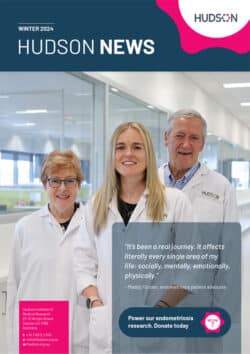Professor Lois A Salamonsen, PhD FRANZCOG (Hon) FAA, Adjunct Professor, Department of Molecular and Translational Science, Monash University
- Distinguished Scientist, Hudson Institute
- lois.salamonsen@hudson.org.au
Professor Lois A Salamonsen is a member of the Centre for Reproductive Health.

Biography
Professor Lois Salamonsen received her Bachelor of Science degree with first class honours in Biochemistry from Otago University (New Zealand) and her PhD in Reproductive Biology from Monash University, Australia.
Her research focuses on human uterine/endometrial biology, specifically on mechanisms underlying endometrial remodelling, including menstruation, endometrial repair, endometrial receptivity for implantation and endometriosis. These findings aim to address a range of clinical problems, including infertility, abnormal uterine bleeding, endometriosis and development of new non-hormonal contraceptives for women. A strong current focus on biomarker discovery will provide markers to guide clinicians in diagnosis and decision making.
Prof Salamonsen has published more than 260 peer-reviewed papers, review articles and book chapters in the fields of endometrial remodelling, implantation and endometriosis, and has >7000 citations. She has held positions as Associate Editor for the international journals Biology of Reproduction and Reproductive Sciences, and served on the Editorial Boards of Endocrinology, Reproductive Biology and Endocrinology and Repropedia, and been a member of the Faculty of 1000.
She is a Fellow and Life Member of the Society for Reproductive Biology, was President of that Society in 2004-2006 and received their premier award, the Founder’s Lecture, in 2009. In 2012, the Royal Australian and New Zealand College of Obstetricians and Gynaecologists awarded Prof Salamonsen an honorary Fellowship, making her one of only three scientists ever to receive this honour. In 2014 she was elected Fellow of the Society for the Study of Reproduction (USA), and in May 2017 she was elected Fellow of the Australian Academy of Science (AAS).
Frontiers in Reproduction USA, honoured her commitment to training and mentoring young scientists with the Beacon Award (2014), acknowledging her “efforts in advancing young scholars’ research careers in the field of reproductive sciences research, and establishing her as a nationally valued source of illumination and guidance – a Beacon – in the development of research careers in the reproductive sciences”. A number of her previous students now head their own substantial research groups.
A strong funding mix has sustained work in the Salamonsen research group over the past 20 years, including funding from the NHMRC, National Institutes of Health (USA), World Health Organisation, Rockefeller Foundation, CONRAD/CICCR (USA), Schering AG, Merck-Serono Foundation (grants for Fertility Innovation) and Monash IVF, as well as a number of philanthropic organisations.
Prof Salamonsen receives regular invitations to speak and to participate in specialist workshops, both nationally and internationally: in 2013-2014 alone, she gave 23 invited presentations.
Prof Salamonsen’s current research involves studying the genes and proteins involved in endometrial remodelling during the menstrual cycle as well as during embryo implantation and early pregnancy, using a variety of established human ex vivo and in vitro models together with genomic (e.g. microarrays, antisense technologies) and proteomic technologies.
She has formed strategic collaborations with specialist clinicians to translate basic research findings into clinically relevant research, including identifying new diagnostics and treatments for disorders of the uterus (such as endometriosis, abnormal uterine bleeding and endometrial infertility).
The group is currently funded by peer-reviewed grants, including project grants from the NHMRC, the Merck-Serono Foundation’s grants for Fertility Innovation, Monash IVF and other philanthropic bodies.
Publication highlights


